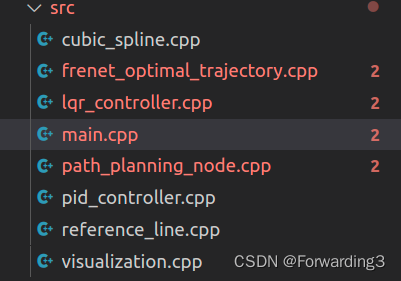项目目录
本项目主要基于深蓝学院规划与控制课程的项目代码,在此基础上做出了一些改进,此帖用于对项目代码做一些梳理。
一 项目代码组成

一. main函数
主要对PathPlanningNode进行初始化
#include <iostream>
#include "path_planning_node.h"
int main(int argc, char** argv) {
ros::init(argc, argv, "path_planning");
PathPlanningNode planning_node;
ROS_INFO("Start Demo!");
if (!planning_node.init()) {
std::cout << "fail to init planning node" << std::endl;
return -1;
}
ros::spin();
return 0;
}
二. pathplanningNode初始化函数
bool PathPlanningNode::init() {
std::string vehicle_odom_topic;
std::string vehicle_cmd_topic;
std::string roadmap_path;
std::string path_vis_topic;
std::string frame_id;
std::string imu_topic;
std::string local_traj_topic = "local_traj";
double speed_P, speed_I, speed_D, target_speed, vis_frequency;
pnh_.getParam("vehicle_odom_topic",
vehicle_odom_topic); //读取车辆定位的topic名
pnh_.getParam("vehicle_cmd_topic",
vehicle_cmd_topic); //读取车辆控制的topic名
pnh_.getParam("roadmap_path", roadmap_path); //读取路网文件名
pnh_.getParam("map_path", map_path_);
pnh_.getParam("path_vis_topic", path_vis_topic); //读取可视化路网名
pnh_.getParam("target_speed", target_speed); //读取目标速度
pnh_.getParam("goal_tolerance", goalTolerance_); //读取到终点的容忍距离
pnh_.getParam("speed_P", speed_P); //读取PID参数
pnh_.getParam("speed_I", speed_I);
pnh_.getParam("speed_D", speed_D);
pnh_.getParam("control_frequency", controlFrequency_); //读取控制的频率
pnh_.getParam("vis_frequency", vis_frequency); //读取路网显示的频率
pnh_.getParam("frame_id", frame_id); //读取全局坐标系名
pnh_.getParam("c_speed", c_speed_); //读取Frenet规划器,初始目标速度
pnh_.getParam("c_d", c_d_); //读取Frenet规划器,初始横向偏差
pnh_.getParam("c_d_d", c_d_d_); //读取Frenet规划器,初始横向速度偏差
pnh_.getParam("c_d_dd", c_d_dd_); //读取Frenet规划器,初始横向加速度偏差
pnh_.getParam("s0", s0_); //读取Frenet规划器,初始纵向距离
pnh_.getParam("imu_topic", imu_topic);
frame_id_ = frame_id;
//加载路网文件
if (!loadRoadmap(roadmap_path, target_speed)) return false;
GetWayPoints(); //在参考路径的基础上进行踩点
speedPidControllerPtr_ = std::shared_ptr<PIDController>(
new PIDController(speed_P, speed_I, speed_D));
lqrController_ = std::shared_ptr<LqrController>(new LqrController());
lqrController_->LoadControlConf();
lqrController_->Init();
// 可视化
visualization_ = VisualizationPtr(new Visualization(nh_));
// 加载参考线
if (use_reference_line_) {
LoadReferenceLine();
}
// 构建相对平滑的Frenet曲线坐标系,一个中间暂时方案
csp_obj_ = new Spline2D(wx_, wy_);
// 全局路径可视化
PlotGlobalPath();
// Update Obstacle
// 添加虚拟障碍物
UpdateStaticObstacle();
roadmapMarkerPtr_ =
std::shared_ptr<RosVizTools>(new RosVizTools(nh_, path_vis_topic));
localTrajectoryMarkerPtr_ =
std::shared_ptr<RosVizTools>(new RosVizTools(nh_, local_traj_topic));
VehiclePoseSub_ = nh_.subscribe(vehicle_odom_topic, 10,
&PathPlanningNode::odomCallback, this);
ImuSub_ = nh_.subscribe(imu_topic, 10, &PathPlanningNode::IMUCallback, this);
controlPub_ =
nh_.advertise<lgsvl_msgs::VehicleControlData>(vehicle_cmd_topic, 1000);
visTimer_ = nh_.createTimer(ros::Duration(1 / vis_frequency),
&PathPlanningNode::visTimerLoop,
this); //注册可视化线程
plannerTimer_ = nh_.createTimer(ros::Duration(1 / plannerFrequency_),
&PathPlanningNode::plannerTimerLoop,
this); //注册规划线程
controlTimer_ = nh_.createTimer(ros::Duration(1 / controlFrequency_),
&PathPlanningNode::controlTimerLoop,
this); //注册控制线程
addRoadmapMarker(planningPublishedTrajectory_.trajectory_points, frame_id);
goalPoint_ =
planningPublishedTrajectory_.trajectory_points.back(); //确定目标点
ROS_INFO("planner node and lqr_control_node init finish!");
return true;
}
2.1 loadRoadmap函数
bool PathPlanningNode::loadRoadmap(const std::string &roadmap_path,const double target_speed)
主要的作用是将参考线数据读入,并根据参考线中的x,y坐标计算出每个路径点的航向角,相对于路径起点的累计历程s,路径中每个离散点的曲率,曲率一阶导。
2.1.1 ComputePathProfile函数
bool ReferenceLine::ComputePathProfile(std::vector<double>* headings,std::vector<double>* accumulated_s,std::vector<double>* kappas,std::vector<double>* dkappas)
这个函数对曲率的计算可以参考下面链接里的公式:链接: link
2.2 GetWayPoints()函数
GetWayPoints()
这个函数主要从之前的参考线离散点中每隔10米挑出一个路点,不知道这个有啥用。





 本文详细介绍了基于深蓝学院规划与控制课程的项目代码中的路径规划节点(PathPlanningNode)。主要内容包括main函数对PathPlanningNode的初始化过程,初始化函数的具体实现细节如参数获取、路网文件加载、控制器初始化等,以及关键函数loadRoadmap和GetWayPoints的功能。
本文详细介绍了基于深蓝学院规划与控制课程的项目代码中的路径规划节点(PathPlanningNode)。主要内容包括main函数对PathPlanningNode的初始化过程,初始化函数的具体实现细节如参数获取、路网文件加载、控制器初始化等,以及关键函数loadRoadmap和GetWayPoints的功能。
















 1807
1807

 被折叠的 条评论
为什么被折叠?
被折叠的 条评论
为什么被折叠?








